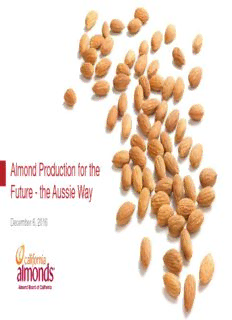
Almond Production for the Future: The Aussie Way PDF
Preview Almond Production for the Future: The Aussie Way
Almond Production for the Future - the Aussie Way December 6, 2016 Almond Production for the Future - the Aussie Way Karen Lapsley, Almond Board of California (Moderator) Neale Bennett, Almond Board of Australia (Moderator) Grant Thorp, Plant and Food Research John Fielke, Unisa Dr. Grant Thorp, Plant and Food Research Transforming Almond Orchards – Tree architecture and advanced production systems Dr Grant Thorp Plant & Food Research Australia Transforming almond orchards • The Australian almond industry has under gone rapid growth • Growers have adopted Californian growing systems and varieties • Yields per hectare are now similar to those obtained in California Question was: “What new growing systems can we develop to lift these yields even further?” 5 Designing new almond orchards New orchard systems must: • Involve no or minimal additional cost to the grower • Reduce the time taken to produce the first commercial crop • Reduce the time to reach break-even point on the orchard investment • Increase productive yield per hectare and grower profit, with improved nut quality 6 Critical knowledge gaps • Physiological responses: what are the constraints of current growing systems that limit productivity (eg carbon partitioning, light distribution) • Tree architecture: working with the natural growth habit of almond varieties to increase production efficiencies • New varieties and rootstocks: what are the best combinations to increase productivity and profit 7 1. Summary of results 2014-16 2. New growing systems Key results 2014/16 “Selective limb removal” pruning – removing the shoulder branches of cropping trees – created more open, spreading tree canopies compared with unpruned trees, with increased light transmission and nut bearing in the lower canopy zones 9 Key results 2014/16 “Palmette” style pruning of young almond trees produced trees with a narrow canopy, suitable for blocks with closer row spacing Nonpareil trees, planted 2012 and pruned in winter 2014 10
Description: